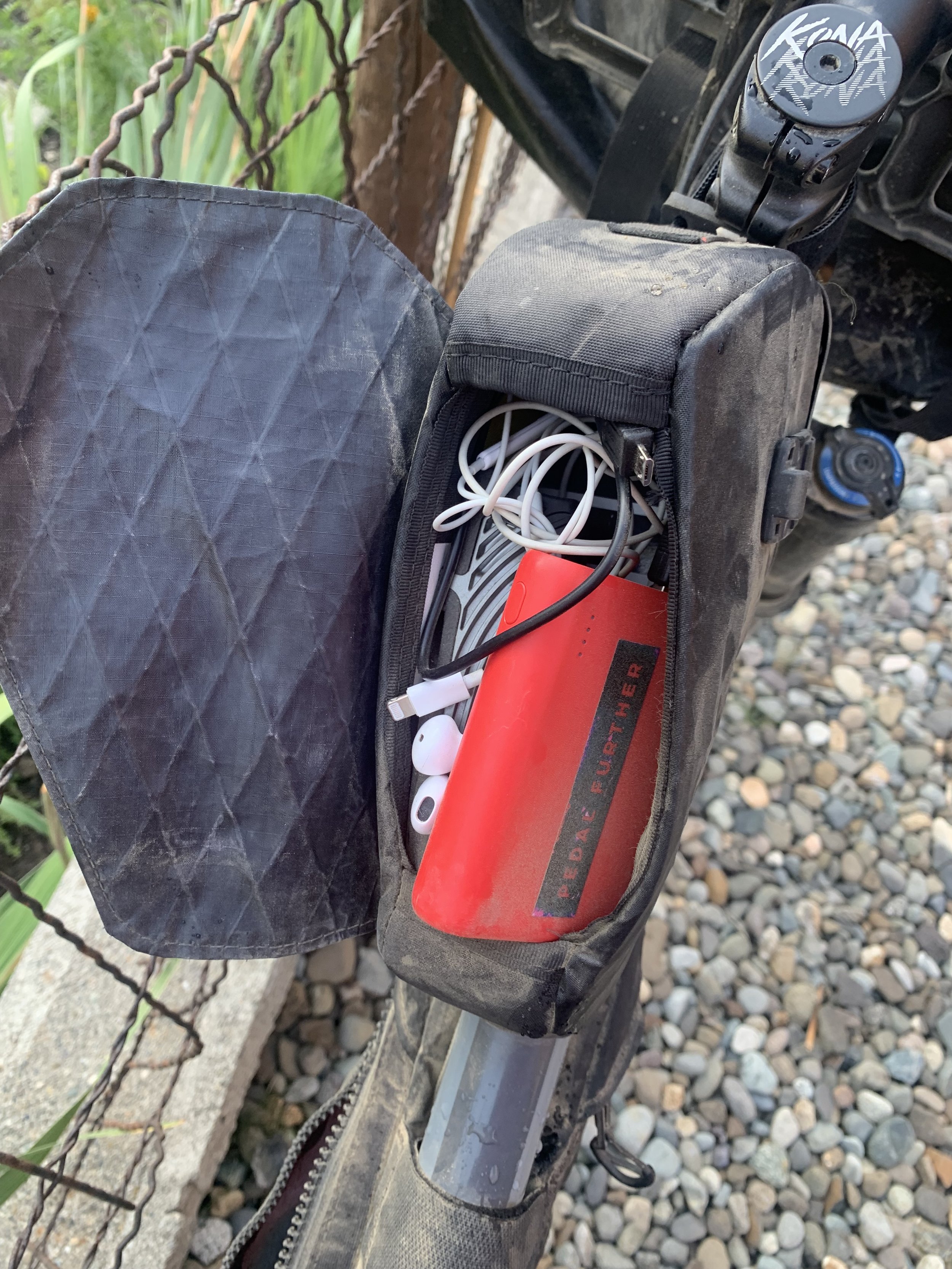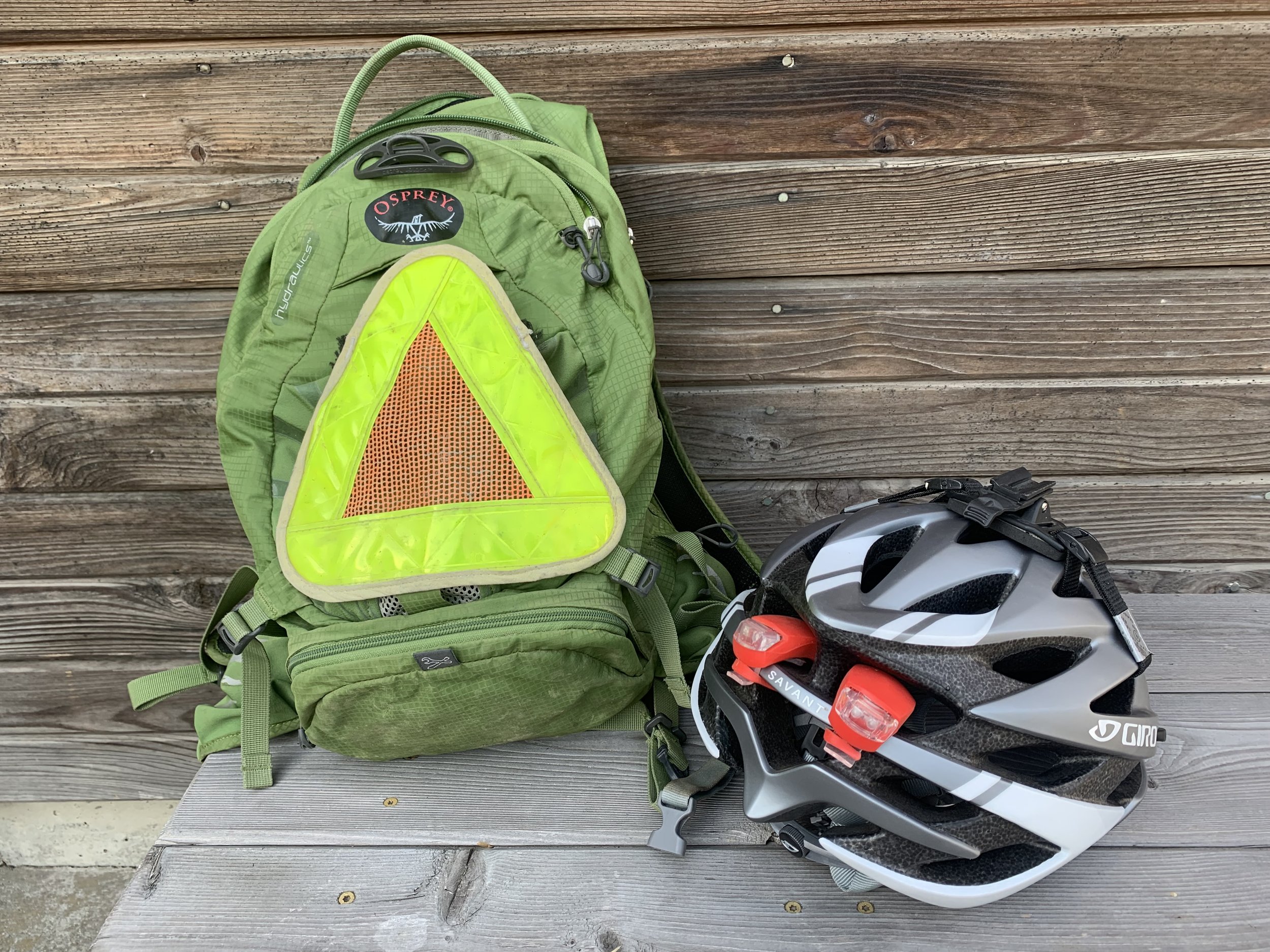Irena’s Gear for Washington High-Lite Route
As I was unpacking, cleaning, sorting and organizing my gear after the Washington High-Lite route, I took a few photos. I didn’t capture everything but enough that I thought it may be fun to document my thinking behind my choices. Every ride and race deserves a fresh look at the gear list and how to pack the bike. There are so many decisions to make beforehand!
I was pretty stoked how much I whittled down my kit. This is probably the lightest that I have ever traveled. However, I expected to be out for only a few days, somewhat close to home and the weather forecast was favorable. So in the end, I didn’t feel like I was taking any big risks.
I rode the Kona Honzo ST bike with 110 mm front fork and Maxxis Ikon 2.35 tires. I like climbing on the Honzo and the High-Lite route had lots of it. I have been experimenting with this bike because I wanted to do a few more technical bikepacking races with singletrack.
The top photo is the nice and clean “before” bike and the bottom is the “after” photo.
The frame bag can fit a surprisingly large amount of food and the zipper can be opened and closed while I am riding if the trail is not too rocky.
My sleep kit included: Montbell sleeping bag cover (bivy), Neo Air Thermarest and Mountain Hardware Phantom 32 sleeping bag.
I loved carrying the sleep kit assembled so that I just needed to unroll it and blow up the Thermarest. It fit nicely into my Salsa Anything cradle on my handlebars.
This is the first season that I have experimented with a bivy rather than sleeping in my tent. It’s worked out very well so far but I have mostly been able to avoid rain and for an early October race, the weather forecast was dry and fairly warm.
Electronics: I brought two cache batteries (one red and the other with the GRIT sticker in the middle photo) and that was enough to keep all the electronics charged. I still brought one wall plug just in case but didn’t use it. I love the Wahoo Elemnt for navigation but find that if I am riding more than 8-10 hours then I need to plug it into the cache battery to charge while I am riding. I don’t let the Wahoo battery get below about 35%. I make sure that the Wahoo is mounted so that it can be charged while riding and the cables are long enough to reach the batteries which I carry in the top tube bag (left photo). I bring wired ear buds for my iPhone so that I can listen to audiobooks* while riding. The iphone stays in Airplane mode and all background refresh on Apps is turned off.
Since the October days are pretty short and I was expecting to ride through most of the night, I brought two lights. They are almost the same, the NiteRider Lumina 1000 and 750. I have a mount on my helmet and my handlebars. The light is fairly heavy so I only put it on my helmet at night. I usually just ride with the helmet light on, unless the trail gets technical which is when I turn on both lights. I always run them on the lowest setting to preserve battery. At some point in the day, I connect them to the cache battery so that they can recharge for a few hours for the next night. Most of the electronics were stored in the top tube bag.
The Spot Gen4 has worked well for me for connecting to Trackleaders and to send daily messages to my husband but I have never had to deploy it for an emergency. I have pre-programmed three messages and use them to let my husband know whether I am stopped for the night and to check-in that all is well. Sometimes, I leave the Spot on for the entire duration of the ride but other times, I have turned it off strategically, so that my exact location is not known. A fresh set of batteries lasts me a few weeks so I don’t bring extras. The Spot is attached to my saddle bag (third photo below) so that the GPS (or whatever magic it uses) does not interfere with my Wahoo.
*Audiobook selection sidebar: I try to pick long novels for riding. Something fully enthralling so that I can get completely lost in the story. So I was excited with my selection of a 22-hour reading of The Fellowship of the Ring (First Lord of the Rings book). I didn’t anticipate that this book would be a bit too scary for me when the hobbits are hiking through the forest and the black rider on a horse is after them etc. I was in the forest, all by myself, at night…. the book was just too much for my imagination.
Kula cloth! I never leave home without it. It travels with me attached on the outside of my saddle bag.
From my saddle bag, starting at the top of the photo: leg warmers, Smartwool long underwear (purple) for sleeping, light wool beanie, extra pair of wool socks (to sleep in and wear on the last day), Patagonia Houdini windbreaker, bike tube, bandaids, headlamp, repair kit (details below), glasses, ear plugs, chain lube with rag and gloves, water filter, Outdoor Research rain jacket, personal hygiene kit (toothbrush, toothpaste, contact lens solution, contact lens case, dental floss, Ibuprofen, lip balm, compressed towelettes), pink Patagonia AlpLight down jacket, poop kit (TP, towelettes, ziplock bags, wet wipes).
I didn’t bring on this trip (but usually do): rain pants, long sleeve wool shirt (to sleep in and for warmth).
My complete repair kit includes: Allen keys, zip ties, duct tape, tire changing levers, tire boot, dynaplugs and tool, small pliers, curved needle and thread, safety pins, knife, Stan’s tire sealant, extra brake pads, pump with electrical tape, spare tube and chain lube/rag/gloves.
The Allen keys are stored in the frame bag for easy access. I clean the chain once or twice a day depending on trail conditions so the chain cleaning kit is easily accessible in the saddle bag.
This is the leftover food. It’s a combination of sweet and savory junk food available at any gas station. I am glad that I didn’t find a leftover burrito or sandwich.
I carry the food in the frame bag along with the pump, which is why it’s included in this photo. It’s not for size. I store some electrical tape on the bike pump.
Frame bag pocket, first photo: Allen keys, knife (switchblade for protection and I know how to use it), lighter, zipties, Aquatabs (water purification tablets) for emergency, caffeine pills and chocolates. For the first time, I tried the caffeine pills/chocolates and I am not sure that they really helped. I am mixed on whether I’d eat them again. I worried that they would cause cramping, which they didn’t but in the end, I was so tired and sleepy that not much could keep me awake.
Top of my backpack, second photo: lip balm with UPF, sunscreen, Aquaphor to help with chafing, route notes. I use Aquaphor because I can generally find it in any grocery store anywhere.
Third photo: Backpack with a reflective triangle where I carried my water in a 2.5L bladder. With a full 1L water filter, I could carry 3.5L of water which was enough for the conditions and re-supply options but on other routes I have carried up to 7L of water. I attached two blinking lights to my helmet. I used to dislike wearing a backpack, but now I find it quite convenient for extra food or water and it’s comfortable (enough).
Fourth photo: Pearl Izumi X-Alp Elevate shoes with Shimano SPD cleats. The shoes are a full size bigger than what I normally wear. I use insoles which I take out if I wear warm socks but in general, this allows my feet to expand as necessary and I no longer lose feeling in my feet.
And finally… the spreadsheet. A bikepacking trip does not happen without a spreadsheet to plan and get organized. I usually put a lot of thought and planning into my races and trips and document my process in a spreadsheet. I usually share it with my bestie and riding partner, Sarah (even if she is not going on the adventure). She helps me make decisions and weigh my options.
For this route, the spreadsheet was short and simple because I was familiar with the route. At some point, maybe I’ll share what I put together for the Smoke ‘n Fire 400 in Idaho or the Utah Mixed Epic last year. Those were much more detailed. Until then, thanks for reading and let me know if I can help you get ready for your next bikepacking adventure!












